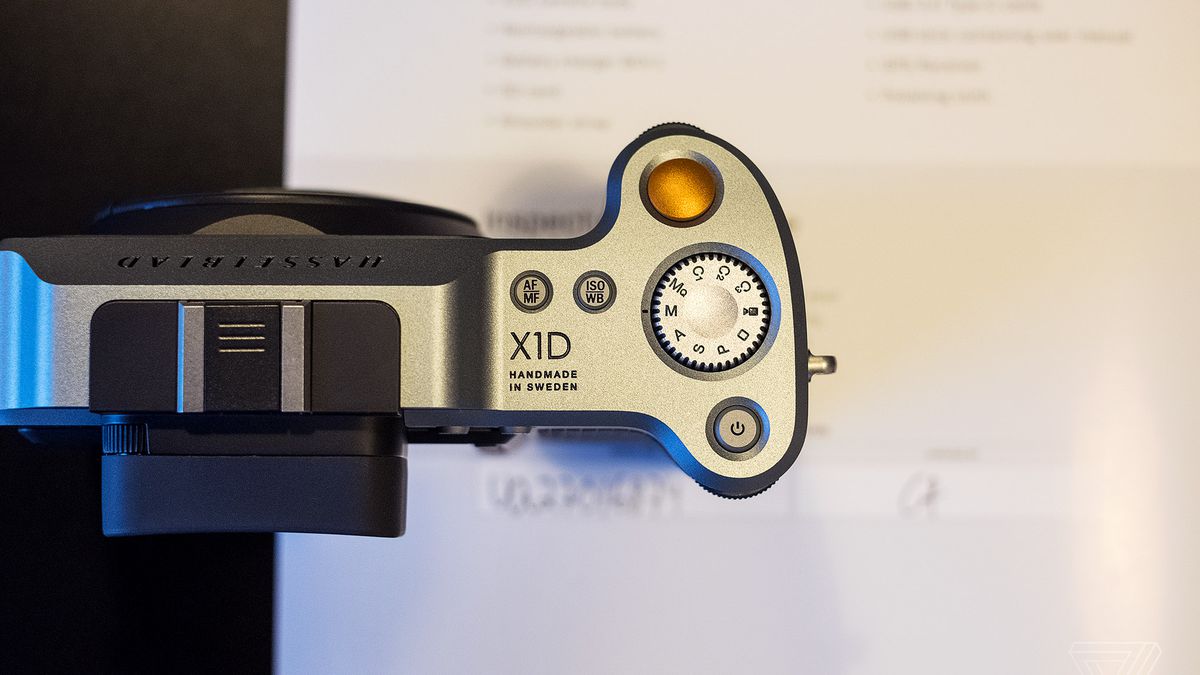chevron_left
-
play_arrow
NGradio So good... like you
This past December, I took a trip to Gothenburg, Sweden, to visit the place that storied camera brand Hasselblad calls home. For Hasselblad, it was an effort to introduce and endear itself to a wider audience than the dedicated photography pro or enthusiast. For me, it was a chance to look behind the marketing curtain and see in person how the (frightfully expensive) magic gets made. Every one of Hasselblad’s most recent X1D cameras comes stamped with a “Handmade in Sweden” inscription, and I was curious to find out just how well-earned that tagline is by the actual production and assembly of these cameras.
Everything about Hasseblad’s products is big: these cameras have large medium format sensors with ridiculously high resolution — 50 megapixels on the X1D, but there’s also a 100-megapixel H6D and a multi-exposure 400-megapixel camera now, too — which have earned the company a grand reputation and a lot of high-profile admirers. The prices aren’t small either, with the most affordable X1D model starting just shy of €10,000 for the camera by itself, with lens prices starting at over €2,000.
Visiting Hasselblad’s main offices, I couldn’t help but be impressed by the array of famous photos on the wall: Jimi Hendrix, Jeff Bridges, the Moon landings, and the Beatles crossing Abbey Road, all shot with a Hasselblad. Even the Hasselblad shutter sound, which I heard up close and personal for myself while trying out an H6D, is perfectly iconic. I found it instantly familiar not because I’d used a Hasselblad before, but because it’s the signature shutter sound that everyone creating artificial shutter sounds for phones and pocket cameras has been copying. This company is a giant in the history of photography.
/cdn.vox-cdn.com/uploads/chorus_asset/file/10160605/vsavov_171213_2285_0001.jpg)
This is why it comes as a shock to discover how tiny Hasselblad, the business, actually is. The entire headquarters, including device assembly, storage, and offices for software development and other operations, is a nondescript three-story building. Anyone who’s attended an English secondary school will find the bland brickwork instantly familiar. There’s simply nothing glamorous to signal the glorious work being done inside. And I get the sense that the people working at Hasselblad very much like it that way. One of Hasselblad’s workers summed it up neatly as “so small and so personal.”
/cdn.vox-cdn.com/uploads/chorus_asset/file/10160579/vsavov_171213_2285_0004.jpg)
Hasselblad sells fewer than 10,000 cameras per year, so it doesn’t need an abundance of space to store or produce them. Above the ground floor, which serves as the company’s warehouse, is the “factory” floor where all the various components are put together and tested to pass exacting standards of quality and durability. While I was there, Hasselblad was busy producing X1D cameras. These are the cheapest, most portable, and most versatile model in its range, and their widespread popularity has surprised Hasselblad.
/cdn.vox-cdn.com/uploads/chorus_asset/file/10160583/vsavov_171213_2285_0005.jpg)
At the earliest stages of assembly, all the tools being used are for minuscule parts and adjustments. Hasselblad doesn’t manufacture any of its parts on site in Sweden, but it puts every screw in place, calibrates, and tests everything to exhaustion.
/cdn.vox-cdn.com/uploads/chorus_asset/file/10160585/vsavov_171213_2285_0006.jpg)
One Hasselblad worker told me that she knows a part is correct just by the feel of it under her thumb, but she checks the measurements just to be sure. Tolerances for measurable imperfections are incredibly low: the length of each Hasselblad camera has to be within 0.02mm of its spec. Yes, that’s narrower than the breadth of a human hair.
/cdn.vox-cdn.com/uploads/chorus_asset/file/10160577/vsavov_171213_2285_0003.jpg)
In most cameras, the shutter mechanism is akin to a curtain that sits in front of the sensor and lifts up when you want to capture a photo. That’s not so with Hasselblad, which chooses to integrate the shutter into the lens instead of the body. Built like an aperture, with eight carbon fiber blades, this shutter introduces less vibration than the usual system, plus it allows photographers to sync their flash up to a much faster speed (1/2,000 of a second). The above is a shutter testing rig that puts each part through a few hundred cycles of opening and closing. The testing is almost entirely automated and the human attending the process is there mostly as a supervisor.
/cdn.vox-cdn.com/uploads/chorus_asset/file/10160587/vsavov_171213_2285_0009.jpg)
This part of the production process was to remove any stray dust and to validate that the full shutter assembly is correct and ready. Specks of dust are a pervasive problem when handling such sensitive photographic gear, and I had to wear one of those lab coats and a hairnet as well.
/cdn.vox-cdn.com/uploads/chorus_asset/file/10160597/vsavov_171213_2285_0007.jpg)
/cdn.vox-cdn.com/uploads/chorus_asset/file/10160589/vsavov_171213_2285_0008.jpg)
/cdn.vox-cdn.com/uploads/chorus_asset/file/10160593/vsavov_171213_2285_0019.jpg)
These densely printed circuit boards grace the back of the 50-megapixel medium format sensor that goes into every Hasselblad X1D.
/cdn.vox-cdn.com/uploads/chorus_asset/file/10160635/vsavov_171213_2285_0020.jpg)
Each of these sensors is manufactured by Sony. As Hasselblad puts it, “Everybody uses the Sony sensors, because you have to.” But where the Swedish company believes it sets itself apart is in the calibration and tuning of that sensor. Hasselblad believes it produces colors that are more true to life than anyone else, and it does have its own color profile, though ultimately the company says it all comes down to how much time you spend perfecting that calibration. Hasselblad dedicates a lot of time to that, and others seem unwilling or unable to match that commitment.
For reference, Fujifilm’s GFX 50S is built around the same 50-megapixel Sony sensor, though it is designed and built in a vastly different way to the X1D.
/cdn.vox-cdn.com/uploads/chorus_asset/file/10160601/vsavov_171213_2285_0015.jpg)
This ominous-looking overhead drill is used when assembling the image sensor with the lens mount and the shutter release button.
/cdn.vox-cdn.com/uploads/chorus_asset/file/10160607/vsavov_171213_2285_0013.jpg)
There’s still a considerable amount of the promised “handmade” work with Hasselblad’s cameras, and one of the striking things about the company’s facility is how basic most of the tools are. This isn’t so much about advanced manufacturing techniques as it is about scrupulous quality control.
/cdn.vox-cdn.com/uploads/chorus_asset/file/10160611/vsavov_171213_2285_0010.jpg)
Any accessory or peripheral that you might need for your Hasselblad camera can be procured from Hasselblad itself, and it’s produced in the same spot as the cameras. The above is a tilt and shift adapter for more creative photographic techniques.
/cdn.vox-cdn.com/uploads/chorus_asset/file/10160595/vsavov_171213_2285_0016.jpg)
This is the assembled main compartment of a Hasselblad H6D, with the signature orange shutter button at the top and the mirror mechanism (for the optical viewfinder) sitting in front of the image sensor.
/cdn.vox-cdn.com/uploads/chorus_asset/file/10160619/vsavov_171213_2285_0017.jpg)
A little peek behind the mirror at that enormous sensor.
/cdn.vox-cdn.com/uploads/chorus_asset/file/10160603/vsavov_171213_2285_0014.jpg)
Once a camera body has been put together and cleared the first set of tests and checks, it is filed away neatly with a signed release from the person who inspected it. Swedish bureaucracy at work.
/cdn.vox-cdn.com/uploads/chorus_asset/file/10160615/vsavov_171213_2285_0023.jpg)
Hasselblad keeps a selection of so-called golden backs, which are perfectly calibrated sensors that the company uses to test its new cameras against. Some of these are pretty ancient by this point, but they still do the job of setting the standard to which Hasselblad’s new hardware needs to adhere.
/cdn.vox-cdn.com/uploads/chorus_asset/file/10160629/vsavov_171213_2285_0024.jpg)
My personal favorite.
/cdn.vox-cdn.com/uploads/chorus_asset/file/10160591/vsavov_171213_2285_0018.jpg)
Assembly and testing are very closely coupled at Hasselblad. The station where a new digital back is put together sits only a few steps away from this testing rig where that new part can be checked and verified to be performing according to spec.
/cdn.vox-cdn.com/uploads/chorus_asset/file/10160613/vsavov_171213_2285_0022.jpg)
Hasselblad uses these big spheres to generate the most uniform color possible, and then it hooks up its cameras to one end and checks to see how well they reproduce that color.
/cdn.vox-cdn.com/uploads/chorus_asset/file/10160621/vsavov_171213_2285_0028.jpg)
/cdn.vox-cdn.com/uploads/chorus_asset/file/10160623/vsavov_171213_2285_0027.jpg)
Testers put each camera through a full battery of checks, with and without memory cards, and it all gets recorded in Hasselblad’s analytics system. The room in which final testing and verification are done is separate from the assembly area, in a space shared with Hasselblad’s repairs program. Because, of course, Hasselblad repairs every camera in the same place that it makes them.
/cdn.vox-cdn.com/uploads/chorus_asset/file/10160609/vsavov_171213_2285_0011.jpg)
Just to underline the point about this not being any sort of hyper-advanced manufacturing, here’s a shot of the typical computer inside Hasselblad’s factory. Windows XP, old school 4:3 monitors from Samsung and Dell, two-inch-thick Sony laptops from decades ago… it’s like Hasselblad collected all its electronics from a tech scavenger yard. But if this old hardware is still doing the job, I guess there’s no reason to buy fancier new equipment.
/cdn.vox-cdn.com/uploads/chorus_asset/file/10160625/vsavov_171213_2285_0026.jpg)
Along with its other low-tech tools, Hasselblad uses these slender little brushes to clean up the trickiest nooks in and around its cameras. To the right of the brushes are the carbon fiber blades used for the shutter mechanism. They’re made out of that material because of the force with which they close; anything lesser would degrade and disintegrate over time. I had to touch one of the shutter blades for myself, and it was, of course, set aside for a thorough clean after I’d made contact with it.
/cdn.vox-cdn.com/uploads/chorus_asset/file/10160627/vsavov_171213_2285_0025.jpg)
Even with the entire floor being sealed away from dust, and with everyone on it wearing protective clothing, there’s still a special area sealed off with these transparent curtains for performing sensor checks and repairs.
/cdn.vox-cdn.com/uploads/chorus_asset/file/10160617/vsavov_171213_2285_0021.jpg)
This batch of all-black X1Ds, each costing in excess of $12,000, represents six figures’ worth of photographic equipment. So yes, it makes sense that each one would come accompanied with exhaustive paperwork.
/cdn.vox-cdn.com/uploads/chorus_asset/file/10160599/vsavov_171213_2285_0012.jpg)
/cdn.vox-cdn.com/uploads/chorus_asset/file/10160633/vsavov_171213_2285_0030.jpg)
Once all the mechanical, electronic, and photographic tests are cleared, the final step is for each camera to be polished and re-checked by hand.
/cdn.vox-cdn.com/uploads/chorus_asset/file/10160637/vsavov_171213_2285_0029.jpg)
One of the things I found impressive about the Hasselblad production facility is how even the gender and age balance of the employees was. There were as many women workers as men, and the person overseeing the first stage of shutter testing was a teenager while the one completing the final packaging was probably twice his age.
/cdn.vox-cdn.com/uploads/chorus_asset/file/10160631/vsavov_171213_2285_0031.jpg)
/cdn.vox-cdn.com/uploads/chorus_asset/file/10160639/vsavov_171213_2285_0032.jpg)
Since most of us are unlikely to ever be so fortunate as to acquire one of these for ourselves, here’s a shot of the Hasselblad X1D-50c box. It’s stark and minimalist, just like the company that produces it, but it comes with everything you need inside. There are power adapters to make the charger compatible with all the various global standards. Plus, Hasselblad has been one of the earliest adopters of USB-C, which comes in handy when you want to tether the camera to your modern computer.
/cdn.vox-cdn.com/uploads/chorus_asset/file/10160643/vsavov_171213_2285_0034.jpg)
So coming back to the “Handmade in Sweden” tag, I feel like the line is fully justified. The stuff that Hasselblad receives from overseas manufacturers is basically just bits of metal, plastic, and printed circuitry. Even the Sony sensors, which are available to everyone across the photo industry, are modified and calibrated to a sufficient degree for their performance to be considered of Hasselblad’s own making.
/cdn.vox-cdn.com/uploads/chorus_asset/file/10160581/vsavov_171213_2285_0002.jpg)
This is the standard test scene by which Hasselblad has been testing its cameras for years. The company takes five exposures with each camera, checks the results, and then recalibrates until it’s happy that the results produced adhere to its high expectations.
/cdn.vox-cdn.com/uploads/chorus_asset/file/10160641/vsavov_171213_2285_0033.jpg)
What I saw while touring the Hasselblad facility is a company that’s not entirely at ease with its status as a global celebrity. Sure, the reception area to the top-floor offices, where official guests are greeted, is graced with the works of people using Hasselblad cameras, but everyone I met there preferred to downplay the company’s reputation rather than inflate it.
Photography by Vlad Savov / The Verge
Source: theverge.com
Written by: New Generation Radio
Similar posts
ΔΗΜΟΦΙΛΗ ΑΡΘΡΑ
COPYRIGHT 2020. NGRADIO





















Post comments (0)